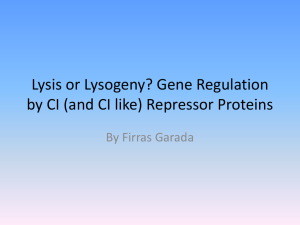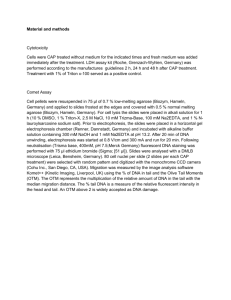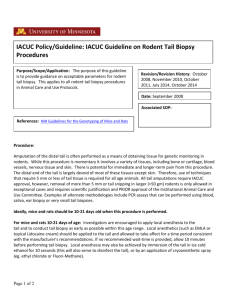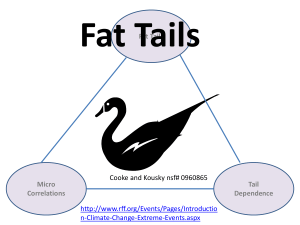Annotated Bibliography
advertisement
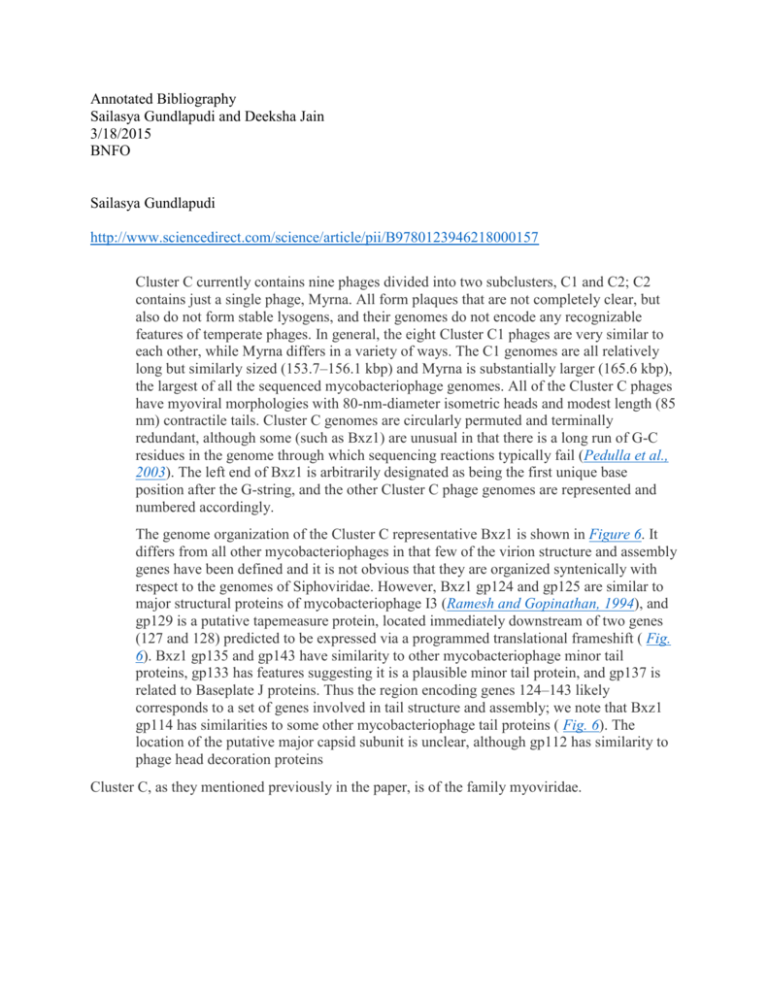
Annotated Bibliography Sailasya Gundlapudi and Deeksha Jain 3/18/2015 BNFO Sailasya Gundlapudi http://www.sciencedirect.com/science/article/pii/B9780123946218000157 Cluster C currently contains nine phages divided into two subclusters, C1 and C2; C2 contains just a single phage, Myrna. All form plaques that are not completely clear, but also do not form stable lysogens, and their genomes do not encode any recognizable features of temperate phages. In general, the eight Cluster C1 phages are very similar to each other, while Myrna differs in a variety of ways. The C1 genomes are all relatively long but similarly sized (153.7–156.1 kbp) and Myrna is substantially larger (165.6 kbp), the largest of all the sequenced mycobacteriophage genomes. All of the Cluster C phages have myoviral morphologies with 80-nm-diameter isometric heads and modest length (85 nm) contractile tails. Cluster C genomes are circularly permuted and terminally redundant, although some (such as Bxz1) are unusual in that there is a long run of G-C residues in the genome through which sequencing reactions typically fail (Pedulla et al., 2003). The left end of Bxz1 is arbitrarily designated as being the first unique base position after the G-string, and the other Cluster C phage genomes are represented and numbered accordingly. The genome organization of the Cluster C representative Bxz1 is shown in Figure 6. It differs from all other mycobacteriophages in that few of the virion structure and assembly genes have been defined and it is not obvious that they are organized syntenically with respect to the genomes of Siphoviridae. However, Bxz1 gp124 and gp125 are similar to major structural proteins of mycobacteriophage I3 (Ramesh and Gopinathan, 1994), and gp129 is a putative tapemeasure protein, located immediately downstream of two genes (127 and 128) predicted to be expressed via a programmed translational frameshift ( Fig. 6). Bxz1 gp135 and gp143 have similarity to other mycobacteriophage minor tail proteins, gp133 has features suggesting it is a plausible minor tail protein, and gp137 is related to Baseplate J proteins. Thus the region encoding genes 124–143 likely corresponds to a set of genes involved in tail structure and assembly; we note that Bxz1 gp114 has similarities to some other mycobacteriophage tail proteins ( Fig. 6). The location of the putative major capsid subunit is unclear, although gp112 has similarity to phage head decoration proteins Cluster C, as they mentioned previously in the paper, is of the family myoviridae. You can see a putative tapemeasure protein (the salmon colored protein after the Tail assembly chaperones) in this figure. http://onlinelibrary.wiley.com/doi/10.1111/mmi.12918/full "The non-contractile tailed siphophages comprise the largest group of phages (Ackermann, 2007). For a siphophage to productively infect a new bacterial cell, it must inject its genome through the multilayered cell envelope. The process by which this occurs is not well understood. In a Gram-negative bacterial cell, the phage genome must pass through the outer membrane, periplasmic space, peptidoglycan layer and inner membrane to gain entry to the bacterial cytoplasm where replication can begin. This process begins with the recognition of a receptor on the cell surface, such as lipopolysaccharide or an outer membrane porin. Studies with phage λ have revealed that the outer membrane protein LamB acts as the phage receptor, but the bacterial inner membrane PtsM complex also plays a role in the infection process (Scandella and Arber, 1976). Other phages have been shown to depend on the presence of different proteins in the cell envelope. The phage tail tape measure protein (TMP) has also been implicated in genome injection. In vitro studies with phage λ revealed that the presence of LamB in liposomes resulted in the TMP extruding from the tail and associating with the liposome (Roessner and Ihler, 1984). This process allowed ions, but not proteins, to traverse the membrane (Roessner and Ihler, 1986). These data suggested that the TMP forms a channel though the host cell membrane that can be used for phage genome entry. Cryo-electron tomography studies of the E. coli podophage T7 (Hu et al., 2013) and siphophage T5 (Bohm et al., 2001) revealed channel-like structures emanating from these phages through the bacterial cell envelope, providing in vivo support for this model. The mechanism(s) by which phage proteins form this channel and interact with host proteins to mediate genome entry are unclear." http://www.sciencedirect.com/science/article/pii/S0022283613004786 "The identifiable strong conservation of gene order appears to be limited to the gpVgpG/gpGT-gpH region across a diverse set of phages [22]. This suggests that these four proteins' function might be closely linked together and that they may evolve as a unit. This is consistent with our results that show that the four proteins' functions are related, with gpGT providing a bridge between major tail protein gpV and tape measure protein gpH. Our results also provide a rational explanation for the broad conservation of frameshifting among dsDNA tailed phages. That is, it appears that both the production of two proteins sharing the same N-terminal sequence and keeping the two proteins in a fixed ratio are very important. We incorporated our results in the assembly pathway shown in Fig. 7. A major difference from the assembly pathways proposed earlier is that we think gpG, gpGT, gpH, and possibly gpV form a subassembly in the assembly pathway. A small amount of gpGT is incorporated into the complex between gpG and gpH. The C-terminus of gpH is probably used to bind to the initiator [17], and gpGT together with other factors in the initiator (e.g., gpL, gpM) induces gpV to polymerize around the tape measure protein. When the tail reaches the length specified by the tape measure protein, it will stop and be capped by gpU. The detailed picture of how gpG, gpGT, gpV, and gpH interact with each other to form the complex structure is not known. How gpG and gpGT are excluded in the final structure and how gpH is cleaved also remain unanswered. Those questions cannot be answered until we have a more detailed structural and biochemical characterization of the tail and tail assembly intermediates." Four proteins gpV, gpG, gpGT, and gpH are linked together and may have evolved together and deal with tail assembly (this includes the tape measure protein, gpH). These four proteins might form a subassembly in the assembly pathway. GpGT gets inbetween gpG and gpH (tapemeasure) proteins. The C-terminus of gpH (tapemeasure) binds to the initiator an gpGT (which is in the initiator) makes gpV polymerize around gpH (tape measure protein). Finally, when the desired tail length is achieved (as dictated by gpH) gpU caps it so it does not exceed it. This is extremely important for our research project as it shows the protein pathways by which the tapemeasure protein interacts with other proteins in order to regulate tail length. http://www.sciencedirect.com/science/article/pii/S0042682284711287 "This report identifies a protein that regulates tail length in bacteriophage T4. Earlier work (Duda et al., 1990) suggested that the gene 29 protein could be involved in T4 tail length determination as a "template" or "tape-measure", similar to that proposed for the gene H protein in bacteriophage λ. We have altered the length of a recombinant gene 29 by constructing deletions and duplications in different parts of the gene. Each of these constructs was incorporated into the high-level expression vector, pET-11d. Seven plasmids with different lengths of gene 29 were made and used in complementation studies. We have found that the length of the tail can be decreased by deleting the Cterminal part of gene 29 or increased by forming duplications in different parts of this gene, and that the length of the tail can be proportional to the size of the engineered protein. Unlike phage λ, plasmids with deletions in the middle of gene 29 or from the Nterminal end produced correspondingly smaller but inactive gene 29 protein and no viable phage were formed. Our results show that alterations in the length of gene 29 protein proportionately alters tail length, and argue strongly for a scheme in which 29 protein is a ruler or template that determines tail length during tail assembly." This paper looked at the putative tapemeasure protein in a phage called T4, a myoviridae bacteriophage. Previous research showed that the Gene 29 Protein could be the tapemeasure protein in this phage. 7 plasmids were made from parts they took from gene 29 in order to see if tail length could be altered by manipulating the gene 29 protein in these plasmids. By deleting the C-terminal of gene 29, they were able to make the tail length shorter. Tail length was also made longer by duplicating parts of the gene and inserting them in the places in the gene. However, sometimes changes made within the protein within the plasmids would result in a nonviable phage, which occured when parts of the N-terminal end or gene 29 were deleted, which resulted in a smaller gene 29 protein and no viable phage. Gene 29 protein in T4 is probably a tape measure protein that regulates tail length during tail assembly. The results of this study are important as usually when a protein is altered, the protein becomes non-viable and loses its ability to function; however, in this case, when the protein was altered in a specific way it was still able to function and aid in assembling a tail (albeit of a different length). This is something to look into further throughout the course of this project. Deeksha Jain http://www.sciencedirect.com/science/article/pii/S1369527406000038 “In bacteriophage λ, the length of the tail (150 nm) is controlled by a 92 kDa protein encoded by gene H (Figure 1a). In-frame deletions and duplications in gene H lead to proportionately shorter or longer tails, and the length of the tail is proportional to the size of the protein, suggesting that the product of gene H (gpH) acts as a molecular ruler or a ‘tape-measure protein’ (TMP) [1 and 6]. gpH is also part of the complex which nucleates polymerization of gpV, the tail subunit protein. This model proposes that gpV polymerizes around gpH, which thus, acts both as a scaffold and a ruler. When the growing tail reaches the amino-terminal domain of the ruler, the end becomes naked, polymerization pauses, and this enables the growth-terminating protein gpU to lock the tail at the correct size and to connect it to a head [7].” http://www.ncbi.nlm.nih.gov/pmc/articles/PMC3185693/#b26-viruses-03-00172 “The length of Sipho- and Myoviridae tails is determined by a tape-measure or ruler protein, also found in cellular complexes such as an injectesome (also called a type III secretion system) and the hook of flagellum [26]. The presence of the ruler protein was first identified in bacteriophage lambda and later in bacteriophage T4 and T5 [167–169]. Presumably, the ruler protein is stretched the entire length of the tail and acts as a scaffold for the polymerization of the tail tube [170]……. The copy number of ruler proteins per phage is unknown, but for the type III secretion system it was determined that only one ruler protein is present per complex [171].” http://www.biomedcentral.com/1471-2164/13/331 “A total of 11 bacteriophage tail structural protein homologs were identified; among these were the bacteriophage tape measure protein, which functions in determination of bacteriophage tail length (homologs 1 (NP_463477), 2 (YP_239811) and 11 (P44236), respectively). Homolog 9 (YP_398561) is a transglycosylase related to the bacteriophage tape measure protein, TP901 family. The bacteriophage protein gp37, homologous to the long tail fiber receptor recognizing protein [homolog 3 (P03744)], allows the specific attachment of the bacteriophage to the bacteria and specifies the host range of the bacteriophage.” http://mmbr.asm.org/content/75/3/423.full “The three Caudovirales families. From left to right are the Myoviridae(T4), the Podoviridae (P22), and the Siphoviridae (p2). (B) Schematic representation of the typical genome organization within theSiphoviridae tail morphogenesis module (this organization is also observed for several myophages with some adaptations). Trp, tail terminator; MTP, major tail protein; C and C*, tail chaperones; TMP, tape measure protein; Dit, distal tail protein; gp27-like/Tal (tail-associated lysozyme or tail fiber), the presence of a C-terminal domain depends on the phage considered; P1 and P2, baseplate/tip peripheral proteins (their number varies among phages).” http://www.sciencedirect.com/science/article/pii/S0022283613004786 "Bacteriophage λ makes two proteins with overlapping amino acid sequences that are essential for tail assembly. These two proteins, gpG and gpGT, are related by a programmed translational frameshift that is conserved among diverse phages and functions in λ to ensure that gpG and the frameshift product gpGT are made in a molar ratio of approximately 30:1. Although both proteins are required and must be present in the correct ratio for assembly of functional tails, neither is present in mature tails. During λ tail assembly, major tail protein gpV polymerizes to form a long tube whose length is controlled by the tape measure protein gpH. We show that the “G” domains of gpG and gpGT bind to all or parts of tail length tape measure protein gpH and that the “T” domain of gpGT binds to major tail shaft subunit gpV, and present a model for how gpG and gpGT chaperone gpH and direct the polymerization of gpV to form a tail of the correct length." http://onlinelibrary.wiley.com/doi/10.1111/j.13652958.2006.05473.x/abstract;jsessionid=349FA57CD100281C174FC49367294823.f01t04?syste mMessage=Wiley+Online+Library+will+be+disrupted+on+7th+March+from+10%3A0013%3A00+GMT+%2805%3A0008%3A00+EST%29+for+essential+maintenance.++Apologies+for+the+inconvenience "Within these phage genomes the tape measure protein (tmp) gene can be readily identified due to the well-established relationship between the length of the gene and the length of the phage tail – because these phages typically have long tails, the tmp gene is usually the largest gene in the genome. Many of these mycobacteriophage Tmp's contain small motifs with sequence similarity to host proteins. One of these motifs (motif 1) corresponds to the Rpf proteins that have lysozyme activity and function to stimulate growth of dormant bacteria, while the others (motifs 2 and 3) are related to proteins of unknown function, although some of the related proteins of the host are predicted to be involved in cell wall catabolism. We show here that motif 3-containing proteins have peptidoglycan-hydrolysing activity and that while this activity is not required for phage viability, it facilitates efficient infection and DNA injection into stationary phase cells. Tmp's of mycobacteriophages may thus have acquired these motifs in order to avoid a selective disadvantage that results from changes in peptidoglycan in non-growing cells."

